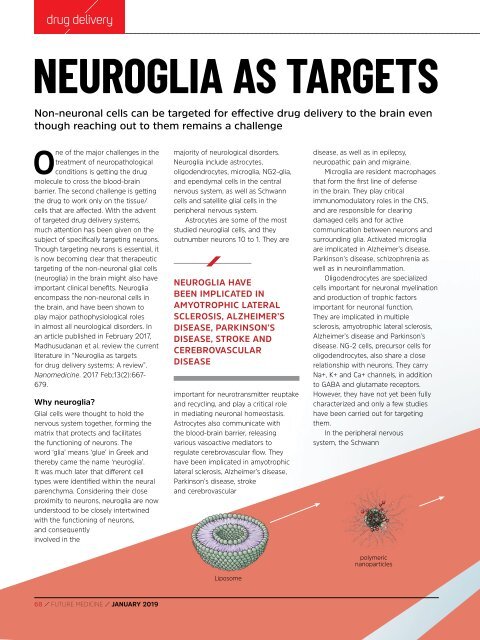FM JANUARY 2019 - digital edition
You also want an ePaper? Increase the reach of your titles
YUMPU automatically turns print PDFs into web optimized ePapers that Google loves.
drug delivery<br />
NEUROGLIA AS TARGETS<br />
Non-neuronal cells can be targeted for effective drug delivery to the brain even<br />
though reaching out to them remains a challenge<br />
One of the major challenges in the<br />
treatment of neuropathological<br />
conditions is getting the drug<br />
molecule to cross the blood-brain<br />
barrier. The second challenge is getting<br />
the drug to work only on the tissue/<br />
cells that are affected. With the advent<br />
of targeted drug delivery systems,<br />
much attention has been given on the<br />
subject of specifically targeting neurons.<br />
Though targeting neurons is essential, it<br />
is now becoming clear that therapeutic<br />
targeting of the non-neuronal glial cells<br />
(neuroglia) in the brain might also have<br />
important clinical benefits. Neuroglia<br />
encompass the non-neuronal cells in<br />
the brain, and have been shown to<br />
play major pathophysiological roles<br />
in almost all neurological disorders. In<br />
an article published in February 2017,<br />
Madhusudanan et al. review the current<br />
literature in “Neuroglia as targets<br />
for drug delivery systems: A review”.<br />
Nanomedicine. 2017 Feb;13(2):667-<br />
679.<br />
Why neuroglia?<br />
Glial cells were thought to hold the<br />
nervous system together, forming the<br />
matrix that protects and facilitates<br />
the functioning of neurons. The<br />
word ‘glia’ means ‘glue’ in Greek and<br />
thereby came the name ‘neuroglia’.<br />
It was much later that different cell<br />
types were identified within the neural<br />
parenchyma. Considering their close<br />
proximity to neurons, neuroglia are now<br />
understood to be closely intertwined<br />
with the functioning of neurons,<br />
and consequently<br />
involved in the<br />
majority of neurological disorders.<br />
Neuroglia include astrocytes,<br />
oligodendrocytes, microglia, NG2-glia,<br />
and ependymal cells in the central<br />
nervous system, as well as Schwann<br />
cells and satellite glial cells in the<br />
peripheral nervous system.<br />
Astrocytes are some of the most<br />
studied neuroglial cells, and they<br />
outnumber neurons 10 to 1. They are<br />
NEUROGLIA HAVE<br />
BEEN IMPLICATED IN<br />
AMYOTROPHIC LATERAL<br />
SCLEROSIS, ALZHEIMER’S<br />
DISEASE, PARKINSON’S<br />
DISEASE, STROKE AND<br />
CEREBROVASCULAR<br />
DISEASE<br />
important for neurotransmitter reuptake<br />
and recycling, and play a critical role<br />
in mediating neuronal homeostasis.<br />
Astrocytes also communicate with<br />
the blood-brain barrier, releasing<br />
various vasoactive mediators to<br />
regulate cerebrovascular flow. They<br />
have been implicated in amyotrophic<br />
lateral sclerosis, Alzheimer’s disease,<br />
Parkinson’s disease, stroke<br />
and cerebrovascular<br />
disease, as well as in epilepsy,<br />
neuropathic pain and migraine.<br />
Microglia are resident macrophages<br />
that form the first line of defense<br />
in the brain. They play critical<br />
immunomodulatory roles in the CNS,<br />
and are responsible for clearing<br />
damaged cells and for active<br />
communication between neurons and<br />
surrounding glia. Activated microglia<br />
are implicated in Alzheimer’s disease,<br />
Parkinson’s disease, schizophrenia as<br />
well as in neuroinflammation.<br />
Oligodendrocytes are specialized<br />
cells important for neuronal myelination<br />
and production of trophic factors<br />
important for neuronal function.<br />
They are implicated in multiple<br />
sclerosis, amyotrophic lateral sclerosis,<br />
Alzheimer’s disease and Parkinson’s<br />
disease. NG-2 cells, precursor cells for<br />
oligodendrocytes, also share a close<br />
relationship with neurons. They carry<br />
Na+, K+ and Ca+ channels, in addition<br />
to GABA and glutamate receptors.<br />
However, they have not yet been fully<br />
characterized and only a few studies<br />
have been carried out for targeting<br />
them.<br />
In the peripheral nervous<br />
system, the Schwann<br />
Liposome<br />
polymeric<br />
nanoparticles<br />
68 / FUTURE MEDICINE / <strong>JANUARY</strong> <strong>2019</strong>


















